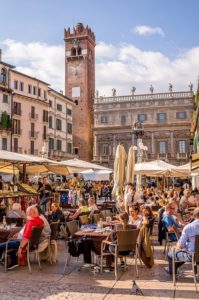
And on the pilgrimage between ‘literary’ love and the Arena, you will wonder if there is a taste route. Delicacies are not lacking throughout the menu. Among the first
dishes certainly stand out: ‘Bigoli con le sardelle’, ‘Gnocchi di patate e sedano rapa di Verona’ (potato and celeriac dumplings) or ‘zucchero e cannella’ (sugar and cinnamon), and ‘Minestra di creste di gallo’ (cockscomb soup), many recipes with polenta, with ‘rico’ and soups of many types, such as ‘Gardesana’ or ‘Russole’. Plus second courses of fish, meat and game, such as ‘Pike in sauce’, ‘Braised in Amarone’, ‘Quails alla scaligera’ or ‘Fried frogs’. Then there is the great panorama of desserts: from ‘Brassadela veronese’, a sort of doughnut characterised by the use of grappa, to ‘Bole’ with chestnut flour, or ‘Cotognata’, ‘Potòna’ and ‘Rufioi’ there is just the tapestry of choice.
Finally, how could one not stroll a little in Verona’s oldest square, ‘Piazza delle Erbe’![]() , or in the largest, also in the historic centre, ‘Piazza Bra’
, or in the largest, also in the historic centre, ‘Piazza Bra’![]() (from the Lombard ‘Breit’, meaning ‘wide’). And then there is always the Adige, which allows you to stroll along its banks and banks, and, crossing its beautiful bridges, allows you to land on the left bank, where the so-called ‘other Verona’, or ‘Veronetta’ (from ‘Veronette’, as it was renamed by Napoleon!), rich in treasures and evocative scenery, opens up.
(from the Lombard ‘Breit’, meaning ‘wide’). And then there is always the Adige, which allows you to stroll along its banks and banks, and, crossing its beautiful bridges, allows you to land on the left bank, where the so-called ‘other Verona’, or ‘Veronetta’ (from ‘Veronette’, as it was renamed by Napoleon!), rich in treasures and evocative scenery, opens up.

Starting from ‘Ponte Pietra’![]() you find yourself in front of the ‘Scalone di San Pietro’
you find yourself in front of the ‘Scalone di San Pietro’![]() and the Austrian barracks ‘Castel San Pietro’
and the Austrian barracks ‘Castel San Pietro’![]() ; then there is the church of ‘San Giovanni in Valle’
; then there is the church of ‘San Giovanni in Valle’![]() ; going down via ‘Santa Maria in Organo’
; going down via ‘Santa Maria in Organo’![]() you reach the church of the same name, which according to Vasari was ‘the most beautiful in Italy’.
you reach the church of the same name, which according to Vasari was ‘the most beautiful in Italy’.
And again the ‘Giardiano Giusti’![]() one of the most beautiful examples of an Italian Renaissance garden, a sort of paradise of greenery and, behind the ‘Duomo’, the ‘Palazzo del Vescovado’, where it is said that Giovanni Della Casa started to write the manual of good manners, the ‘Galateo’.
one of the most beautiful examples of an Italian Renaissance garden, a sort of paradise of greenery and, behind the ‘Duomo’, the ‘Palazzo del Vescovado’, where it is said that Giovanni Della Casa started to write the manual of good manners, the ‘Galateo’.
Verona was the birthplace of many important names in culture, such as Emilio Salgari, Sandokan’s father, with his first success ‘The Tiger of Malyasia’, published in 1883, in the Veronese newspaper ‘La Nuova Arena’.
Lastly, to wink at folklore and fun, we must not forget the ‘Veronese Carnival’ of ‘Venerdì Gnocolar’: a tasty challenge to elect the ‘Papà del Gnocco’ (Dad of the Dumpling)!
